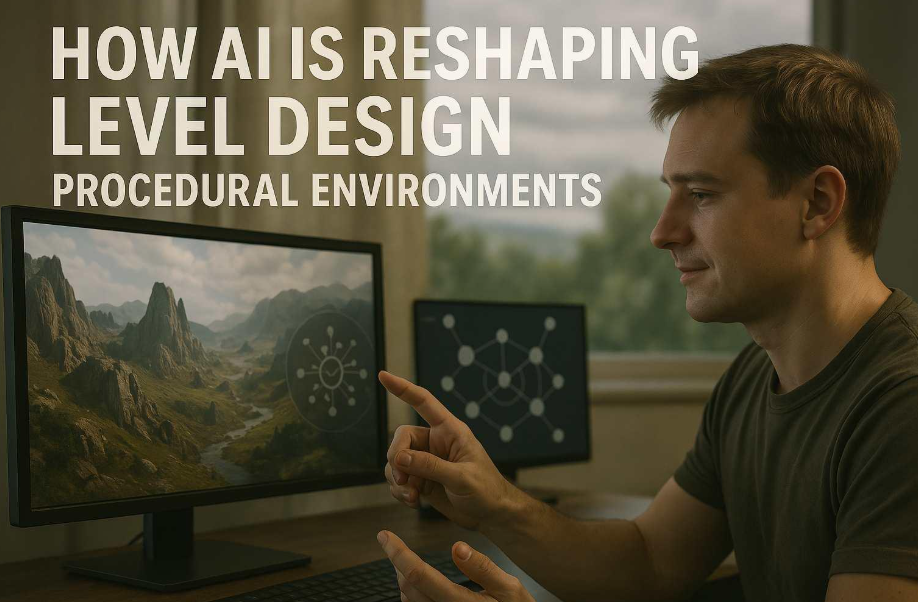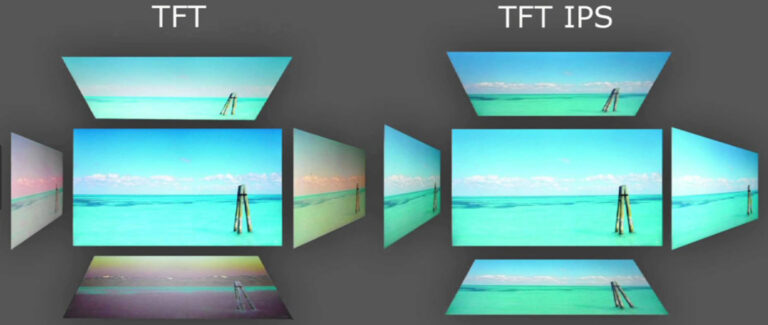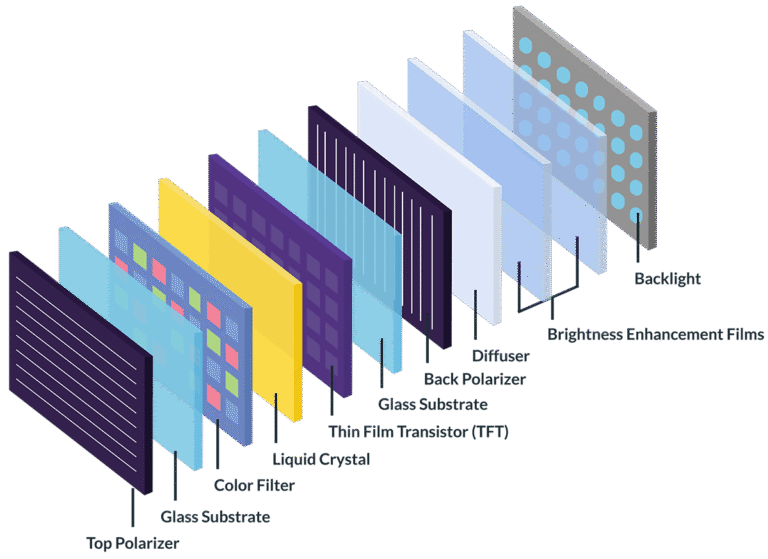
Introduction
In the changing world of video game design, artificial intelligence (AI) plays an important role. It is changing how developers create game levels. Tools like Houdini, Unity’s procedural generator, and Generative Adversarial Networks (GANs) have changed how environments are made in modern game engines. This article explores how AI affects level design and provides useful insights for game developers, video game journalists, and content strategy managers who want to use these new tools.
The Intersection of AI and Gaming
AI has been a topic of interest in gaming for a long time. It can be seen as both a helper and an enemy in games. But AI is more than just characters in a game; it plays a big part in game design too. AI helps build large, changing worlds that respond to how players interact with them, improving the gaming experience. This is especially clear in procedural level design, where a mix of algorithms and creativity creates detailed and engaging environments.
AI as a Creative Partner
AI serves as a creative partner in the game development process, empowering developers to push the boundaries of design. By handling repetitive tasks and making data-driven decisions, AI allows creators to focus more on artistic aspects and innovative ideas. This partnership leads to a harmonious blend of human creativity and machine precision, ensuring that each virtual world is as unique as the imagination behind it.
Dynamic World-Building
The adaptability of AI in gaming allows for dynamic world-building that evolves with player interaction. Unlike static environments, AI-driven worlds can change in response to player choices, creating a personalized gaming experience. This dynamism not only enhances engagement but also encourages replayability, as players are motivated to explore different scenarios and outcomes.
Enhancing Player Experience
AI plays a crucial role in enhancing the player experience by creating environments that are not only visually stunning but also narratively compelling. By integrating AI, developers can design levels that align seamlessly with the story, ensuring that each element of the environment contributes to the overall narrative arc. This integration results in a more immersive and emotionally resonant gaming experience.
Procedural Generation: A New Era in Level Design
Procedural generation is not a new concept in gaming, but the advent of sophisticated AI tools has elevated it to unprecedented heights. By employing algorithms that define rules and constraints, developers can generate vast game worlds with minimal manual intervention. This method not only saves time and resources but also introduces variability and replayability, crucial factors for maintaining player engagement.
The Evolution of Procedural Generation
The evolution of procedural generation has been marked by significant advancements in AI technology. Earlier iterations relied heavily on randomization, often resulting in repetitive and uninteresting environments. However, with AI, procedural generation has become more nuanced, capable of producing complex and aesthetically pleasing landscapes that are both unpredictable and coherent.
Balancing Creativity and Automation
A key challenge in procedural generation is balancing creativity with automation. While AI offers tools for efficient environment creation, the creative vision must still be guided by human designers. By setting parameters and constraints, developers can ensure that AI-generated content aligns with the game’s artistic direction and narrative goals, thus maintaining a harmonious balance between automation and creativity.
Expanding Replayability and Engagement
One of the most significant benefits of AI-driven procedural generation is its ability to expand replayability. By creating diverse and dynamic worlds, players are encouraged to explore different paths and strategies, leading to increased engagement. This variability not only extends the lifespan of a game but also enhances its value, as players find new reasons to return to the game world time and again.
AI Design Tools: Houdini and Unity
Houdini and Unity stand at the forefront of AI-powered procedural generation tools, offering developers the means to create complex environments with remarkable precision. Houdini’s procedural workflow allows for the creation of detailed landscapes and structures, leveraging node-based systems to automate the design process. Unity’s procedural generator, on the other hand, provides a user-friendly interface for crafting dynamic environments that respond to player actions.
Harnessing Houdini’s Capabilities
Houdini’s capabilities in procedural generation are unparalleled, offering a flexible and robust toolset for game developers. Its node-based workflow allows for intricate control over every aspect of environment design, from terrain generation to asset placement. This flexibility enables developers to experiment with different design elements and iterate quickly, resulting in highly detailed and cohesive game worlds.
The Power of Unity’s Interface
Unity’s procedural generator simplifies the process of creating interactive environments, making it accessible to Unity3d developers of all skill levels. Its intuitive interface allows for easy manipulation of game elements, enabling developers to craft dynamic and responsive worlds. By leveraging Unity’s capabilities, even small indie studios can produce high-quality environments that rival those of larger studios.
Empowering Innovation Across the Industry
The availability of advanced AI tools like Houdini and Unity democratizes game development, empowering both freelance developers and large studios to innovate. By lowering the barrier to entry, these tools enable a wider range of creators to participate in the industry, fostering diversity and inclusivity. This democratization of tools encourages a rich variety of game experiences, catering to a broader audience and enriching the gaming landscape.
The Value of Hiring Specialized Developers
In today’s competitive gaming landscape, game dev for hire services can provide a significant advantage. Hiring specialized developers brings unique skills and expertise tailored to specific areas of game development, ensuring a high-quality end product. These professionals can handle everything from core mechanics and visual effects to backend integration and platform optimization.
- Expert Knowledge: Specialized developers possess in-depth knowledge of their respective fields, whether it’s AI integration, level design, or graphic arts. This expertise allows them to implement advanced techniques and tools effectively, elevating the overall quality of the game.
- Increased Efficiency: By bringing in developers who are adept in specific areas, teams can streamline the development process. These experts can navigate complex challenges more rapidly and produce results that align with the project’s vision.
- Innovation and Creativity: Specialized developers are often at the forefront of emerging technologies and trends. Their insights and innovative approaches can inspire creative solutions and unique gameplay mechanics that set your game apart from competitors.
- Quality Assurance: Skilled developers understand best practices and industry standards. Their involvement helps ensure that the game runs smoothly, is free of bugs, and meets player expectations, enhancing the user experience.
- Tailored Development: Having a team of specialized developers allows for a more tailored development approach. They can focus on what they do best while collaborating seamlessly with others, leading to a well-rounded and cohesive project.
- Cost-Effectiveness: While hiring specialized developers may seem like a higher initial investment, their ability to deliver quality work efficiently can save costs in the long run. Fewer revisions and less rework mean more efficient use of resources.
Incorporating the new section in this location provides valuable context to the discussion about tools and the importance of expert contributions in game development.
GANs: The Future of AI in Level Design
Generative Adversarial Networks, or GANs, represent a groundbreaking approach to AI-driven level design. By pitting two neural networks against each other—a generator and a discriminator—GANs can create environments that mimic human-designed levels with astonishing fidelity. This technique opens new avenues for creativity, allowing developers to explore design possibilities that were previously unattainable.
Unveiling GANs’ Potential
The potential of GANs in level design is vast, offering new methods for creating realistic and imaginative environments. By leveraging GANs, developers can generate textures, landscapes, and assets that are indistinguishable from those crafted by human designers. This capability not only enhances visual fidelity but also provides a foundation for more immersive and believable game worlds.
Overcoming Design Limitations
GANs offer a solution to many of the limitations faced in traditional level design. By automating the creation of complex assets, GANs free up valuable time for developers to focus on refining gameplay and storytelling. This efficiency allows for the exploration of more ambitious projects, breaking free from the constraints of manual design processes.
Opening New Avenues for Creativity
The creative possibilities unlocked by GANs are immense, enabling developers to push the boundaries of what is possible in game design. By experimenting with GAN-generated content, developers can discover new artistic styles and gameplay mechanics that were previously out of reach. This exploration leads to innovative and unique gaming experiences that captivate and inspire players.
The Implications for Game Developers
For game developers, the integration of AI in level design offers a dual advantage: creative freedom and operational efficiency. By automating routine tasks, developers can focus on refining gameplay mechanics and storytelling, ensuring that each element of the game contributes to a cohesive and engaging experience. Furthermore, AI’s ability to simulate real-world physics and behaviors results in environments that feel authentic and responsive, enhancing player immersion.
Streamlining the Development Process
AI technologies streamline the development process by handling time-consuming tasks such as asset creation and environment detailing. This efficiency allows teams to allocate resources more effectively, reducing development time and costs. By optimizing workflows, developers can bring their creative visions to life more rapidly, resulting in quicker project turnarounds and increased productivity.
Enhancing Gameplay Mechanics
Incorporating AI into level design enhances gameplay mechanics by creating environments that react to player interactions in real-time. AI-driven worlds can adapt based on player choices, providing a more dynamic and engaging experience. This adaptability not only increases player satisfaction but also encourages experimentation, as players discover new ways to interact with the game world.
Ensuring Long-Term Player Engagement
AI’s ability to create responsive and immersive environments is key to ensuring long-term player engagement. By crafting worlds that resonate with players on an emotional and intellectual level, developers can cultivate a loyal player base. This engagement is crucial for the longevity of a game, as players are more likely to invest time and resources into experiences that offer continuous growth and discovery.
Enhancing Narrative and Player Engagement
AI’s role in level design extends beyond aesthetics; it is instrumental in crafting narratives that resonate with players. By generating environments that reflect the story’s themes and emotional tones, AI ensures that the setting is not just a backdrop but an integral part of the storytelling process. This synergy between narrative and environment fosters a deeper connection between the player and the game, encouraging prolonged engagement and exploration.
Creating Immersive Storytelling Environments
AI-driven environments offer a new dimension to storytelling by creating settings that are alive with narrative potential. By aligning environmental design with story arcs, developers can craft worlds that enhance the emotional impact of the narrative. This integration results in a more cohesive and immersive storytelling experience, drawing players deeper into the game world.
Building Emotional Connections
AI enables developers to build emotional connections between players and the game world by tailoring environments to evoke specific feelings and moods. By using AI to analyze player behavior and preferences, developers can create personalized experiences that resonate on a deeper level. These connections foster player loyalty and encourage ongoing engagement with the game.
Encouraging Exploration and Discovery
AI-driven level design encourages exploration and discovery by creating environments that are rich in detail and intrigue. By designing worlds that are both visually stunning and narratively compelling, developers can inspire players to delve deeper into the game’s mysteries. This sense of discovery enhances player satisfaction and encourages continued engagement with the game.
The Role of AI in Shaping Gaming Communities
AI not only influences game design but also plays a crucial role in shaping gaming communities. By facilitating the creation of diverse and inclusive environments, AI-driven tools enable developers to cater to a broader audience. This inclusivity is essential for fostering a vibrant and active gaming community, where players from different backgrounds can share their experiences and insights.
Promoting Inclusivity and Diversity
AI-driven tools empower developers to create diverse game worlds that reflect a wide range of cultures and perspectives. By incorporating elements from various backgrounds, developers can craft inclusive environments that resonate with a global audience. This diversity not only enriches the gaming experience but also promotes a more inclusive and accepting gaming community.
Fostering Player Collaboration
AI can facilitate player collaboration by creating environments that encourage teamwork and social interaction. By designing levels that require cooperative strategies and communication, developers can foster a sense of community among players. This collaboration enhances the multiplayer experience, leading to more meaningful and lasting player relationships.
Supporting Community Growth
AI plays a vital role in supporting the growth of gaming communities by providing tools for content creation and customization. By enabling players to modify and share game content, AI-driven tools empower players to contribute to the game’s evolution. This active participation fosters a sense of ownership and investment, leading to a more engaged and passionate community.
Sparking Debate and Interaction
For video game journalists and content strategy managers, AI’s impact on level design presents an opportunity to spark meaningful discussions within the gaming community. Articles that explore the ethical implications of AI, its potential to democratize game development, and its influence on player behavior can engage readers and foster interaction. By positioning AI as a catalyst for debate, content creators can elevate the discourse surrounding gaming and encourage a more informed and engaged audience.
Exploring Ethical Considerations
The integration of AI in game design raises important ethical considerations, such as the implications of AI decision-making and the potential for bias. By exploring these topics, content creators can encourage critical thinking and dialogue within the gaming community. This discourse is essential for ensuring that AI advancements are implemented responsibly and ethically.
Examining AI’s Impact on Game Development
AI’s influence on game development is profound, offering both opportunities and challenges. By analyzing the impact of AI on design processes, content creators can provide valuable insights into the future of the industry. This examination helps developers, journalists, and players understand the potential of AI to reshape the gaming landscape.
Engaging the Community in Dialogue
AI’s role in gaming offers a unique opportunity to engage the community in meaningful dialogue. By addressing topics such as AI’s influence on storytelling and player behavior, content creators can foster discussions that extend beyond the gaming world. This engagement not only elevates the quality of gaming discourse but also encourages a more informed and thoughtful audience.
Conclusion: Embracing the AI Revolution in Gaming
As AI continues to reshape the landscape of level design, its potential to revolutionize the gaming industry becomes increasingly apparent. By harnessing the power of AI tools like Houdini, Unity’s procedural generator, and GANs, developers can create worlds that captivate and inspire. For game developers, video game journalists, and content strategy managers, embracing AI is not just a necessity but an opportunity to redefine the boundaries of what is possible in gaming.
The Future of AI in Game Design
The future of AI in game design is bright, offering endless possibilities for innovation and creativity. As AI technologies continue to evolve, developers will have access to even more sophisticated tools and techniques. This evolution promises to push the boundaries of what is possible, leading to groundbreaking gaming experiences that captivate players worldwide.
Collaborating with AI for Greater Innovation
The collaboration between human creativity and AI technology is a powerful force driving innovation in game design. By embracing AI as a creative partner, developers can unlock new levels of artistic expression and technical achievement. This synergy between human and machine promises to redefine the gaming landscape, offering players richer and more immersive experiences.
Embracing Change and Innovation
In this era of innovation, AI stands as a testament to the limitless possibilities of technology and creativity. As the gaming industry continues to evolve, embracing AI is essential for staying competitive and relevant. By welcoming change and innovation, developers, journalists, and content creators can contribute to a vibrant and dynamic gaming ecosystem that inspires and engages players across the globe.




